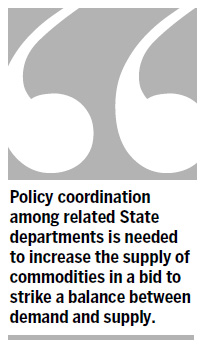Opinion
Containing inflation at the root
By Guo Tianyong (China Daily)
Updated: 2010-12-02 14:48
 |
Large Medium Small |
Tightening excess money supply and increasing competitive investment could help lower commodity prices
The recent rises in commodity prices and looming inflation have become of increasing concern, not just to the Chinese government, but also to many ordinary people.

Since it turned positive at the end of 2009, the country's consumer price index (CPI) has kept rising. Data from the National Bureau of Statistics (NBS) showed that the CPI rose to a 25-month high of 4.4 percent in October, up 0.7 percent on September.
The price hikes of foods and household items have proven to be the main factor pushing up prices. According to the NBS data, food prices in October grew 10.1 percent year-on-year and contributed 74 percent to the month's CPI growth, and the price of consumer commodities increased 4.9 percent from a year earlier, which contributed 16.6 percent to the increased CPI that month. At the same time, the producer price index (PPI) in October increased 5 percent year-on-year, a 0.7 percent rise from September.
Since the start of 2010, prices of some domestic basic foods - from garlic and ginger, to soybeans, apples and sugar - have experienced big rises, sparking a chain reaction in the price of other commodities and aggravating public concerns over inflation. The latest round of inflation pressure has mainly stemmed from the combination of a series of internal and external factors, including monetary and economic ones.
Monetary over-supply has been blamed as the main cause of the looming inflation. Since the start of the global financial crisis, the Chinese government has introduced a series of stimulus packages and offered a comparatively loose monetary environment to ensure economic recovery.
However, despite helping revive the national economy the ever-expanding lending volumes have also caused fluidity excess. By the end of September, the country's M2 volume had reached 69.64 trillion yuan ($10.44 trillion). That means that the country's central bank has over-issued a total of 42 trillion yuan, given that China's gross domestic product (GDP) in the first three quarters was only 26.87 trillion yuan.
Monetary over-supply has undoubtedly fuelled price rises, which, together with speculation by investors, has continuously pushed up the price of properties and consumer commodities.
In addition, trade surplus and the inflow of hot money have also added to China's over fluidity.
The frequent incidence of natural disasters, from a severe drought in the country's southwest during the first half of this year, to a catastrophic earthquake in Qinghai province and flooding in Hainan province, has also led to the short supply of some agricultural products, aggravating price rises in recent months.
A new round of quantitative easing adopted by the United States has also fuelled the price rises of some bulk commodities, adding to China's imported inflation pressures. Following its issuance of $1.725 trillion-worth of bonds, the US Federal Reserve Board announced on Nov 4 a move to buy $600 billion-worth of national debt.
The move, which means a second round of quantitative easing in the world's largest economy, has increased the amount of US currency flooding the world market and pushed up the prices of a variety of consumer commodities in the global market, especially some bulk commodities.
As a result, production costs for some domestic sectors have increased, increasing inflation pressures.
The rising prices will undercut people's purchasing power, middle and low-income groups in particular, as indicated by the drastic decline of consumer confidence among the country's rural and low-income residents.
Besides, the rising production costs will also squeeze companies' profits and prompt them to shift part of their increased costs to consumers.
|
||||
The move, an indication of the central bank's resolve to tighten monetary fluidity and tame inflation, has to some extent helped stabilize consumer confidence.
The country's future macroeconomic policy should focus on how to rein in inflation by controlling liquidity and monetary supplies. The country should moderately tighten its monetary policy through properly utilizing interest rates and reserves in a bid to optimize its resources distribution in the capital market.
At the same time, the government should increase subsidies to middle and low-income groups to prevent their living conditions from declining as the result of inflation.
Policy coordination among related State departments is needed to increase the supply of commodities in a bid to strike a balance between demand and supply.
A well-developed competitive mechanism should also be adopted to standardize investment and strengthen monitoring and control over hot money.
The author is head of the China Banking Research Center at the Central University of Finance and Economics.



